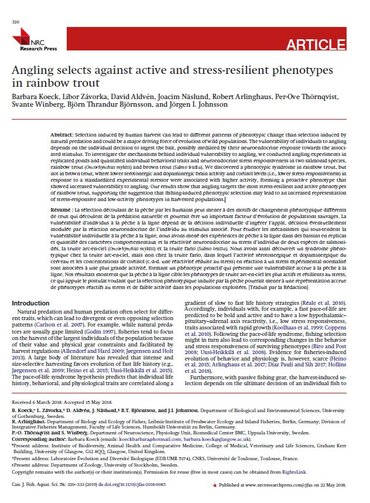Selection induced by human harvest can lead to different patterns of phenotypic change than selection induced by natural predation and could be a major driving force of evolution of wild populations. The vulnerability of individuals to angling depends on the individual decision to ingest the bait, possibly mediated by their neuroendocrine response towards the associated stimulus. To investigate the mechanisms behind individual vulnerability to angling, we conducted angling experiments in replicated ponds and quantified individual behavioral traits and neuroendocrine stress responsiveness in two salmonid species, rainbow trout (Oncorhynchus mykiss) and brown trout (Salmo trutta). We discovered a phenotypic syndrome in rainbow trout, but not in brown trout, where lower serotonergic and dopaminergic brain activity and cortisol levels (i.e., lower stress responsiveness) in response to a standardized experimental stressor were associated with higher activity, forming a proactive phenotype that showed increased vulnerability to angling. Our results show that angling targets the most stress-resilient and active phenotypes of rainbow trout, supporting the suggestion that fishing-induced phenotypic selection may lead to an increased representation of stress-responsive and low-activity phenotypes in harvested populations.
Angling selects against active and stress-resilient phenotypes in rainbow trout
Rezensierter Artikel

Koeck, B., Závorka, L., Aldvén, D., Näslund, J., Arlinghaus, R., Thörnqvist, P.-O., Winberg, S., Björnsson, B. T., Johnsson, J. I. (2019). Angling selects against active and stress-resilient phenotypes in rainbow trout. Canadian Journal of Fisheries and Aquatic Sciences, 76, 320–333
Veröffentlicht
: 2019
Erschienen in
: Canadian Journal of Fisheries and Aquatic Sciences, 76, 320–333
